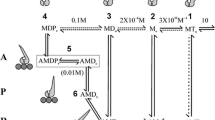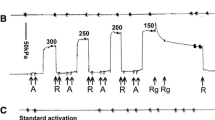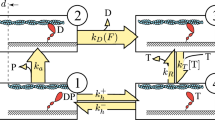Abstract
We have measured the effect of phosphate (Pi) on the tension and maximum shortening velocity of permeable rabbit psoas fibers. Work in a number of laboratories has established that addition of phosphate (0–25 mM) to active muscle fibers at physiological MgATP concentrations decreases isometric tension with little effect on the maximum shortening velocity. Here we extend these results to a wider range of Pi concentrations and to low MgATP concentrations. Low levels of Pi (approx. 150 μM – 200 μM) were obtained by using sucrose phosphorylase and sucrose to reduce contaminating Pi in the solutions used to activate the fiber, and high levels (52–73 mM) were obtained by replacing acetate with Pi as the principal anion. In an activating solution containing either 50 μM or 4 mM MgATP, pH 6.2 or 7.0, isometric tension declines linearly with the logarithm of Pi concentration. Although the isometric tension decreases with increasing concentrations of H+ or MgATP, the slope of relative isometric tension as a function of log[Pi] is the same at the two values of pH and [MgATP]. At pH 7 and 4 mM MgATP, the velocity of contraction increased slightly as Pi increased from 0.2 to 52 mM. At 50 μM MgATP the velocity decreased slightly as Pi increased from 10 to 52 mM. These results are discussed in terms of models of cross-bridge energetics. The observation that force declines linearly with the logarithm of [Pi] is compatible with models in which a major force producing state occurs subsequent to Pi release. The inhibition of shortening velocity by Pi at low concentration of MgATP can be explained by a competition between MgATP and Pi at the end of the cross-bridge powerstroke.
Similar content being viewed by others
References
Abbott RH, Mannherz HG (1970) Activation by MgADP and the correlation between tensions and ATPase activity in insect fibrillar muscle. Pflügers Arch 321:223–232
Altringham JD, Johnston IA (1985) Effects of phosphate on the contractile properties of fast and slow muscle from an Antarctic fish. J Physiol 368:491–500
Bagshaw CR, Trentham DR (1974) The characterization of myosin-product complexes and of product release steps during Mg-dependent adenosine triphosphatase reaction. Biochem J 141:331–349
Brozovich FV, Yates LD, Gordon AM (1988) Muscle force and stiffness during activation and relaxation. Implications for the actomyosin ATPase. J Gen Physiol 91:399–420
Chase PB, Kushmerick MJ (1988) Effects of pH on contraction of rabbit fast and slow skeletal muscle fibers. Biophys J 53:935–946
Cooke R (1986) The mechanism of muscle contraction. CRC Crit Rev Biochem 21:53–118
Cooke R, Bialek W (1979) Contraction of glycerinated muscle fibers as a function of MgATP concentration. Biophys J 28:241–258
Cooke R, Pate E (1985) The effects of ADP and phosphate on the contraction of muscle fibers. Biophys J 48:789–798
Cooke R, Franks K, Luciani G, Pate E (1988) The inhibition of rabbit skeletal muscle contraction by hydrogen ions and phosphate. J Physiol 395:77–97
Dantzig JA, Laktis JW, Homsher E, Goldman Y (1987) Mechanical transients initiated by photolysis of caged Pi during active skeletal muscle contraction. Biophys J 51:3a
Donaldson SKB, Hermansen L (1978) Differential, direct effects of H+ on Ca2+-activated force of skinned fibers from the soleus, cardiac, and adductor magnus muscle of rabbits. Pflügers Arch 376:55–65
Eisenberg E, Hill TL, Chen Y (1980) Cross-brige model of muscle contraction. Biophys J 29:195–227
Ferenczi MA, Simmons RM, Sleep JA (1982) General considerations of cross-bridge models in relation to the dependence on MgATP concentration of mechanical parameters of skinned fibers from frog muscle. In: Twarog BM, Levine RJC, Dewey MM (eds) Basic biology of muscles: a comparative approach. Raven Press, New York, pp 91–107
Ferenczi MA, Goldman YE, Simmons RM (1984) The dependence of force and shortening velocity on substrate concentration in skinned muscle fibers fromRana temporaria. J Physiol (Lond) 350:519–543
Herzig JW, Peterson JW, Ruegg JC, Solaro RJ (1981) Vanadate and phosphate ions reduce tension and increase cross-bridge kinetics in chemically skinned heart muscle. Biochem Biophys Acta 672:191–196
Hibberd MG, Trentham DR (1986) Relationships between chemical and mechanical events during muscular contraction. Ann Rev Biophys Biophys Chem 15:119–161
Hibberd MG, Dantzig JA, Trentham DR, Goldman YE (1985) Phosphate release and force generation in skeletal muscle fibers. Science 228:1317–1319
Hill TL (1977) Free energy transduction in biology. Academic Press, New York London
Huxley AF (1957) Muscle structure and theories of contraction. Prog Biophys 7:255–318
Kawai M (1986) The role of orthophosphate in crossbridge kinetics in chemically skinned rabbit psoas fibers as detected with sinusoidal and step length alterations. J Muscle Res Cell Motil 7:421–434
Kawai M, Guth K, Winnikes K, Haist C, Ruegg JC (1987) The effect of inorganic phosphate on ATP hydrolysis rate and the tension transients in chemically skinned rabbit psoas fibers. Pflügers Arch 408:1–9
Kentish JC (1986) The effects of inorganic phosphate and creatine phosphate in skinned muscles from rat ventricle. J Physiol 370:585–604
Martell AE, Smith RM (1974) Critical stability constants, vol 1. Plenum Press, New York
Nihei T, Noda L, Morales MF (1961) Kinetic properties and equilibrium constant of the adenosine triphosphate—creatine transphosphorylase catalyzed reaction. J Biol Chem 236:3203–3209
Nosek TM, Fender KY, Godt RE (1987a) It is diprotonated inorganic phosphate that depresses force in skinned skeletal muscle fibers. Science 236:191–193
Nosek TM, Fender KY, Godt RE (1987b) Influence of inorganic Pi and related compounds on contraction of skinned muscle fibers. Biophys J 51:5a
Pate E, Cooke R (1989) A model of cross-bridge action: the effects of ATP, ADP, and Pi. J Muscle Res Cell Motil (in press)
Ruegg JC, Schadler M, Steiger GJ, Miller G (1971) Effects of inorganic phosphate on the contractile mechanism. Pflügers Arch 325:359–364
Silverstein R, Voet J, Reed D, Abeles R (1967) Purification and mechanism of action of sucrose phosphorylase. J Biol Chem 242:1338–1346
Sleep J, Glyn H (1986) Inhibition of myofibrillar actomyosin subfragment 1 adenosinetriphosphatase by adenosine 5′-diphosphate, pyrophosphate, and adenyl-5′-yl imiododiphosphate. Biochemistry 25:1149–1154
Sleep J, Hutton R (1980) Exchange between inorganic Pi and ATP in the medium by actomyosin subfragment-1. Biochemistry 19:1276–1283
Ulbrich M, Ruegg JC (1977) Mechanical factors affecting the ATP-phosphate exchange reaction in insect flight muscle. In: Tregear RT (ed) Insect flight muscle. Elsevier/North Holland, Amsterdam New York, pp 317–333
Webb MR, Hibberd MG, Goldman YE, Trentham DR (1986) Oxygen exchange between Pi in the medium and water during ATP hydrolysis mediated by skinned fibers from rabbit skeletal muscle. Evidence for Pi binding to a force-generating state. J Biol Chem 261:15557–15564
White DCS, Thorson J (1972) Phosphate starvation and the nonlinear dynamics of insect fibrillar muscle. J Gen Physiol 60:307–336
Yoshizaki K, Seo Y, Nishikawa H, Morimoto T (1982) Application of pulsed-gradient31P NMR on frog muscle to measure the diffusion rates of phosphorous compounds in cells. Biophys J 38:209–211
Author information
Authors and Affiliations
Rights and permissions
About this article
Cite this article
Pate, E., Cooke, R. Addition of phosphate to active muscle fibers probes actomyosin states within the powerstroke. Pflugers Arch. 414, 73–81 (1989). https://doi.org/10.1007/BF00585629
Received:
Revised:
Accepted:
Issue Date:
DOI: https://doi.org/10.1007/BF00585629




